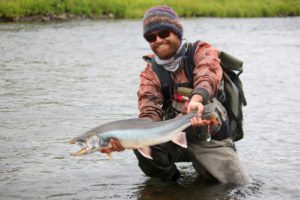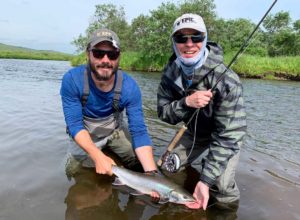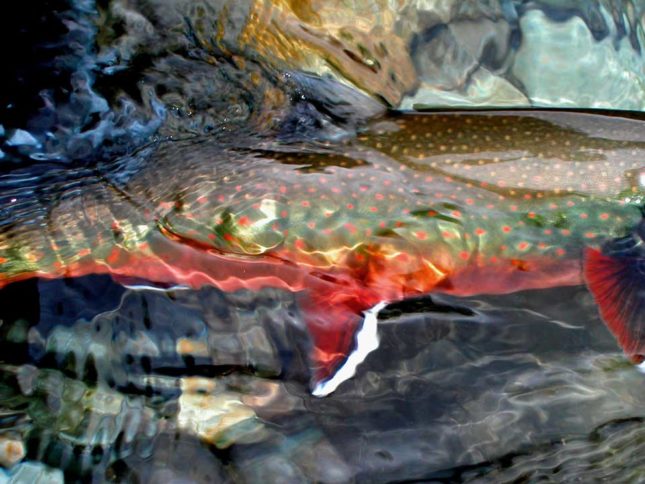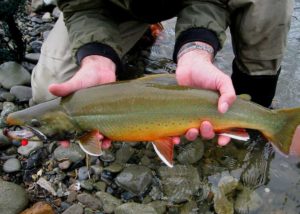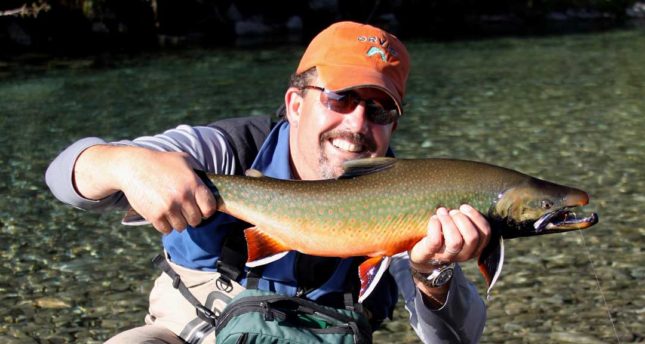Epic Blog
Seven Species Series: Dolly Varden (cont’d)
08.10.20
Part Four: Dolly Varden (continued)
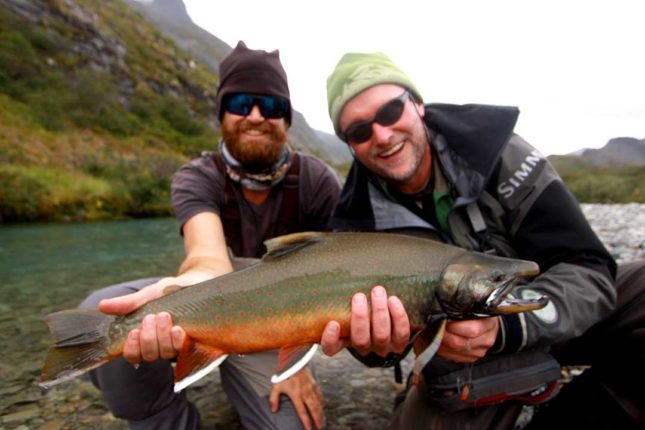
Many anglers first travel to Alaska to fly fish for trout or salmon. Many return for the dollies. South side.
The all you can eat egg buffet
Dolly Varden are ferocious predators. They are the perfect combination of being both opportunistic and fearless in their willingness to attack a fly. At our first camp we see them arrive hot on the heels of the first wave of chum salmon. Typically, by the end of the first week of July, dolly fishing is wide open. The ones in our creek have come from the salt, like the chums, but unlike their salmon relatives they never venture as far out to sea. Instead they stay within the nearshore habitat of the coast, foraging for crustaceans and bait fish. Once the annual summer spawning migration kicks off, bringing millions of salmon back into their natal rivers and streams, the Dolly Varden hordes arrive. They have come for the all you can eat egg buffet.
XXL
Many times if you can locate where a pod of salmon are holding in our creek, you have simultaneously found where the dollies are: right behind them with their mouths open. Typically we’re going to be running anything from streamers, to topwater (Dolly Varden love chasing the mouse!) to rigging a pegged bead under an indicator. You’re going to want a sturdy rod for chasing these fish at our tundra camp. Something in the 6 – 7 wt range with a stiff backbone for launching large, heavier flies. It varies year to year, but certain runs can reach jumbo sized proportions. My first two seasons of guiding at OUTPOST fell into this category. We we’re consistently catching fish that averaged well over twenty inches. Some of the bigger specimens pushed the envelope, flirting with thirty.
Back into the weeds
Now this is interesting to consider, this variation in size. We catch Dolly Varden at both of our camps, OUTPOST and SAFARI. In a way they link those two venues together, being a kind of common denominator for our guests and guides alike. But, for anyone who has experienced both camps in recent years, you may have noticed a disparity in the average size of Dolly Varden between the two operations*. They are, on average, smaller at our second camp on the Pacific coast. Why is this generally the case?
Close but no cigar
Before we dive into a conversation discussing the variables in different Dolly Varden populations, let’s resolve to answer an earlier posed question: are Dolly Varden and Arctic Char the same thing? The answer is no, they’re not. What makes this such a confusing topic* is that the two fish can in fact look nearly identical to one another. Even more confusing is that they share much of the same range, often overlapping. This is especially true in Alaska. It doesn’t help our cause that Arctic Char are considered to be one of the most dimorphic animals on earth.
Eye of the beholder
If you do a google image search of Dolly Varden an array of photos showing brightly colored fish is going to pop up. Most will be depicted in their full spawning colors; a stunning combination of dark green bodies with blood red bellies, their backs and sides littered with hot red polka dots. Capping off this Autumnal display are the brilliant white rays that run down the front of their pectoral, pelvic and anal fins.
But here’s the kicker, half of the fish that show up on your screen will in all likelihood be Arctic Char, not Dolly Varden. One of the biggest tell tales to distinguish between the two are the size of those bright red spots. Look carefully. On Dolly Varden they’re small, smaller than the size of their pupil. On Arctic Char the dots are larger than the pupil. A few other notable differences are that sexually mature male Dolly Varden will display a prominent kype while Arctic Char do not. One last clue is the shape of their tale fin. Arctic Char will typically have a noticeably forked tale, while Dolly Varden have more of a clubbed tale.
If you’re still confused just remember this: both species are char, so to refer to a Dolly Varden as a char would be like calling a Cutthroat a trout. No harm, no foul.
North side, South side
Okay, we’re getting somewhere, but were not out of the woods yet folks. Alaska has two distinct populations of Dolly Varden. A northern one and a southern one. This sheds much light on the Dolly Varden size differential found between our two remote wilderness camps**. The dividing line between these two distinct forms: The Alaska Peninsula. On the Pacific side (SAFARI camp) you find the southern form. They have more chromosomes and fewer vertebrae than their northern counterparts and typically do not grow as large. The northern form found on the Bering/Bristol Bay side of the peninsula and extending north into the Arctic Circle are capable of reaching much greater proportions. These larger specimens are what we typically run into at our OUTPOST camp.
***So, while we fish for Dolly Varden at both camps, we probably encounter two very distinct populations.
Nothing is written in stone
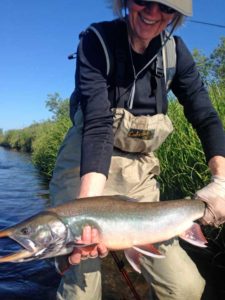
The OUTPOST camp dollies have been noticeably larger than SAFARI camp dollies for the last several seasons. North side.
Ultimately all of this makes for interesting conjecture at the breakfast table before the day’s fishing has begun, or while enjoying the view at our observation deck overlooking the tidal flat at our SAFARI camp. It should be noted, however, that there are always a hundred exceptions to any rule, and the Dolly Varden remains in many ways an evolving category when we try to distinguish it from Arctic Char. We should remind ourselves that it wasn’t long ago that Steelhead were separated into several different species by scientists, while today they have been consolidated into one camp.
It does not take a far stretch of the imagination to envision a time in the future when something similar would determine a resolution between Dolly Varden and Arctic Char. We as anglers have the unique advantage to experience first hand the many fluctuations, shifting trends, and hidden secrets that inform our knowledge of a given species. Sometimes those experiences align with the general consensus, while at other times they seem to contradict conventional wisdom.
Time will tell
We’ve come a long way from that long ago day when a group of anglers laid their catch out before the Inn keepers niece and proposed an innocent question. Sadly, the population of fish that gave birth to the name Dolly Varden are no more. Bull Trout have been extirpated from the waters of Northern California. They live on only as a story we tell about another fish.
That fish, whose story is still being written, is for me one of the crown jewels of the Alaska fly fishing experience. They are like trout, but more veracious. They are like salmon, but more beautiful. Their obscure name tells you absolutely nothing about them, shrouding them in a cloak of mystery. Often, when I find myself day dreaming of the water I have come to know so well, the fanning tail outs, boulder jams and crystalline pools, I see them full of many fish, but there is only one that I want.
Written by Drew Griffith (aka “Machete”). June, 2020
Find more Machete articles here.
Editor’s Notes:
*To make the debate even more confusing, according to Alaska Fish & Game Dolly Varden are generally sea-going fish, but there’s also lake and river residents. And Arctic Char are generally lake and river resident fish, but there’s also sea-going populations.
**As with many natural trends, it hasn’t always been this way. For the last 8 or so seasons the size disparity between the two operations is indisputable.
***Unique exceptions exist in the southern range (aka, secret drainages), where fish grow to larger than normal proportions. Are these a genetically superior southern form, a lost northern form… or perhaps hybrids?
Posted in All Posts, Fishing, OUTPOST, SAFARI

